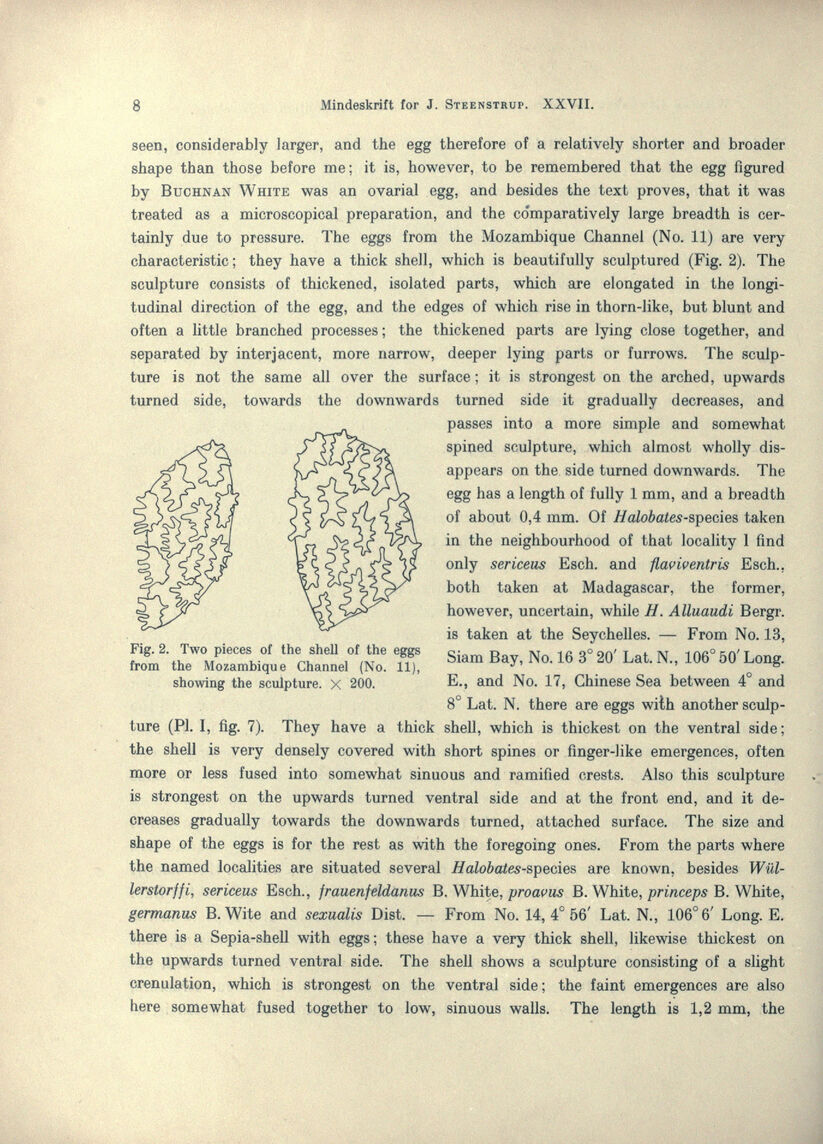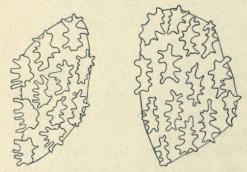
Full resolution (JPEG)
- On this page / på denna sida
- Some Remarks on the Eggs and Egg-deposition of Halobates

<< prev. page << föreg. sida << >> nästa sida >> next page >>
Below is the raw OCR text
from the above scanned image.
Do you see an error? Proofread the page now!
Här nedan syns maskintolkade texten från faksimilbilden ovan.
Ser du något fel? Korrekturläs sidan nu!
This page has been proofread at least once.
(diff)
(history)
Denna sida har korrekturlästs minst en gång.
(skillnad)
(historik)
seen, considerably larger, and the egg therefore of a relatively shorter and broader
shape than those before me; it is, however, to be remembered that the egg figured
by Buchnan White was an ovarial egg, and besides the text proves, that it was
treated as a microscopical preparation, and the comparatively large breadth is
certainly due to pressure. The eggs from the Mozambique Channel (No. 11) are very
characteristic ; they have a thick shell, which is beautifully sculptured (Fig. 2).
 |
Fig. 2. Two pieces of the shell of the eggs
from the Mozambique Channel (No. 11),
showing the sculpture. X 200. |
The
sculpture consists of thickened, isolated parts, which are elongated in the
longitudinal direction of the egg, and the edges of which rise in thorn-like, but blunt and
often a little branched processes ; the thickened parts are lying close together, and
separated by interjacent, more narrow, deeper lying parts or furrows. The
sculpture is not the same all over the surface ; it is strongest on the arched, upwards
turned side, towards the downwards turned side it gradually decreases, and
passes into a more simple and somewhat
spined sculpture, which almost wholly
disappears on the side turned downwards. The
egg has a length of fully 1 mm, and a breadth
of about 0,4 mm. Of Halobates-species taken
in the neighbourhood of that locality I find
only sericeus Esch. and flaviventris Esch.,
both taken at Madagascar, the former,
however, uncertain, while H. Alluaudi Bergr.
is taken at the Seychelles. — From No. 13,
Siam Bay, No. 16 3° 20’ Lat. N., 106° 50’ Long.
E., and No. 17, Chinese Sea between 4° and
8° Lat. N. there are eggs with another
sculpture (Pl. I, fig. 7). They have a thick shell, which is thickest on the ventral side;
the shell is very densely covered with short spines or finger-like emergences, often
more or less fused into somewhat sinuous and ramified crests. Also this sculpture
is strongest on the upwards turned ventral side and at the front end, and it
decreases gradually towards the downwards turned, attached surface. The size and
shape of the eggs is for the rest as with the foregoing ones. From the parts where
the named localities are situated several Halobates-species are known, besides
Wüllerstorffi, sericeus Esch., frauenfeldanus B. White, proavus B. White, princeps B. White,
germanus B.Wite and sexualis Dist. — From No. 14, 4° 56’ Lat. N., 106° 6’ Long. E.
there is a Sepia-shell with eggs; these have a very thick shell, likewise thickest on
the upwards turned ventral side. The shell shows a sculpture consisting of a slight
crenulation, which is strongest on the ventral side; the faint emergences are also
here somewhat fused together to low, sinuous walls. The length is 1,2 mm, the
<< prev. page << föreg. sida << >> nästa sida >> next page >>
Project Runeberg, Sun Dec 10 11:30:24 2023
(aronsson)
(diff)
(history)
(download)
<< Previous
Next >>
https://runeberg.org/japetus100/xxvii/0008.html




